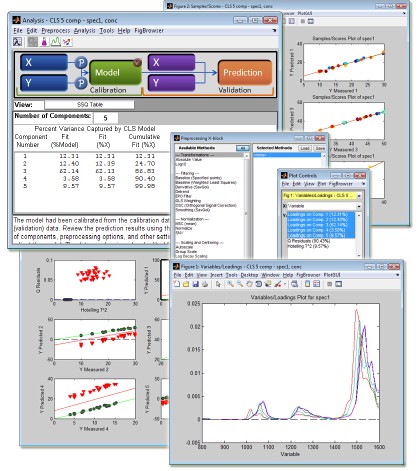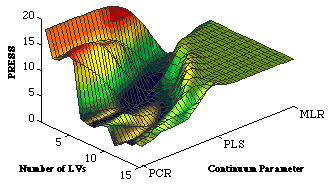|
Welcome to the world's most extensive suite of chemometric tools!
The PLS_Toolbox is a collection of advanced chemometric routines, i.e., tools designed specifically for modeling data from chemical systems. Originally named for the partial least squares (PLS) routines that have become a mainstay for calibration model development, the PLS_Toolbox now contains over 300 functions that can be used in a variety of technical areas. |
|---|
This includes linear and nonlinear modeling tools, along with functions that help the user apply them in the chemical laboratory or process environment. Tools included in the toolbox are point and click graphical user interfaces for principal components analysis and partial least squares regression and a suite of tools for the analysis of multi-way data.

PLS_Toolbox tools include...
- Data Exploration and Pattern Recognition (Principal Components Analysis, Parallel Factor Analysis, MCR, Purity, Tucker Models...)
- Classification (SIMCA, k-nearest neighbors, PLS Discriminant Analysis, Cluster Analysis with Dendograms...)
- Linear and Non-Linear Regression (PLS, Principal Components Regression, N-way PLS, Locally Weighted Regression...)
- Self-modeling Curve Resolution, Pure Variable Methods (CODA_DW, Purity (compare to SIMPLSMA), CompareLCMS...)
- Curve fitting and Distribution fitting and analysis tools
- Instrument Standardization (Piece-wise Direct, Generalized Least Squares Preprocessing...)
- Advanced Graphical Data Set Editing and Visualization Tools
- Advanced Customizable Order-Specific Preprocessing (Centering, Scaling, Smoothing, Derivatizing...)
- Missing Data Support
- Variable Selection (Genetic algorithms, IPLS, purity-based analysis)
System Requirements
If you are using MATLAB 6.5, 7.x or higher (R13.1 through R2007b) you are ready to use PLS_Toolbox. PLS_Toolbox does not require other MATLAB toolboxes. Like all MATLAB toolboxes, PLS_Toolbox is platform independent. It will function on any platform on which MATLAB functions (e.g. MAC, PC, UNIX, Linux).
